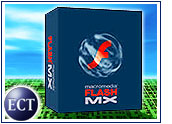
Flash animation — once widely derided as a bells-and-whistles annoyance — is quickly becoming ubiquitous, thanks to the prevalence of broadband connections and a freely distributed plug-in for nearly every major computing platform. In fact, Flash technology, developed by Macromedia, has become so widespread that many companies are starting to think of it as a platform unto itself.
Autodemo, one such company, uses Flash technology as the development platform for its entire line of products. Autodemo’s products come in two varieties. One is software demos designed to help software companies promote products. The other is Web demos designed to help users navigate Web sites. Both are developed with Flash.
When Autodemo started operating five years ago, it created these demos for distribution on CDs. But once modem speeds began to increase and low-cost broadband started making inroads into the marketplace, the firm started building its software with Flash.
“Flash has changed dramatically,” Autodemo founder and chief executive J.C. Stites told TechNewsWorld. “The functionality underlying [the Flash] platform is getting more sophisticated; all of the things that you can do on the Web are now getting integrated into Flash applications.”
Flash Back
But Flash technology was not always so well received. As recently as 1999, usability expert Jakob Nielsen waged war against Flash designers in his popular book, Designing Web Usability.
Nielsen was upset with Web designers who seemed to spend more time creating flashy interactive graphics than providing intuitive access to information. Headings in his book deriding Flash declared that “splash screens must die” and “Flash is 99 percent bad.”
Stites admitted that Flash did have its drawbacks in the past. He compared the development of Flash to the development of desktop publishing.
“When PageMaker came out, all of a sudden everybody started creating newsletters, and you would get all of these ugly things with clip art in the mail,” said Stites. “So it is understandable that some were critical of Flash at the time. But some companies like ours looked at Flash as a delivery mechanism for something that really did have some value.”
Hesitant Acceptance
Stites cited Amazon, one of Autodemo’s clients, as an example. With the help of Autodemo, Amazon put Flash technology on its site for the first time about two years ago, despite initial hesitance about its use.
Even today, some analysts still warn against using Flash. Others, like Rob Enderle, a research fellow at Forrester, say that although Flash was originally used too often, the technology has moved into the mainstream.
Enderle said Flash is very effective in sales situations in which the salesperson can create a more compelling reason to buy something that the buyer normally would need to see and touch. He noted that the people now using Flash successfully are using it more maturely than the initial adopters.
“The problem remains, however, that once used, the Web designers tend to want to use it to showcase their own skills, and that can often detract from the overall effort,” said Enderle. “Like any powerful tool, when misused, Flash can do more damage than good.”
Flash Forward
Lucian Beebe, a senior product manager at Macromedia, said people have already started creating more mature and intelligent applications with Flash. He added that this will only continue as Flash technology moves forward.
“The big change in the Flash community and with Flash users is the awareness now that you can build applications in Flash,” Beebe told TechNewsWorld.
“Instead of throwing tons of graphics up there, [designers] are thinking harder about great design, and those are the experiences that really don’t bother people.”
The fact that people are starting to refer to Flash as a platform is also part of the maturing process, Beebe noted. “As you think about applications and you think about delivering them on Flash, suddenly Flash does become your platform,” he said.
Platform Penetration
Beebe said he thinks Flash’s biggest competitor right now is what he calls the do-nothing category. “The do-nothing in this case is to go with HTML or not try to make a great experience; the reality is that great experiences take some thought,” said Beebe.
“People are often defaulting to HTML and they are trying to create great Internet experiences using HTML,” he said. “And you can if the great Internet experience you want to create is displaying text to people. But when you want to go beyond that, Flash starts making a lot of sense.”
Beebe said that when thinking of Flash as a platform, it is important to look at the platform’s penetration. He noted that the Flash plug-in is available for almost every operating system and computing platform on the market, including PDAs like Pocket PC. “We are going on cell phones,” said Beebe.
“It is that kind of ubiquity that I think really is opening a lot of eyes and turning a lot of heads in terms of a development platform,” Beebe told TechNewsWorld. “If you talk about Flash maturing — people being able to really trust that Flash is everywhere now — that is a key component of any platform.”




















































